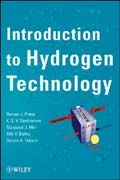
Introduction to hydrogen technology
Press, Roman J.
Santhanam, K.S.V.
Miri, Massoud J.
Bailey, Alla V.
Stressing clean sources of energy, theory of fuel cell operations, hydrogen infrastructure, and devices that use hydrogen, Chemistry for Hydrogen Technology prepares readers for future challenges in the areas of energy generation, consumption, and commercialization of hydrogen-powered applications. The text raises awareness for renewable energy use and leads to preparation of a workforce that will be ready for future challenges in the areas of energy generation, consumption, and commercialization of hydrogen-powered applications. The author team covers chemistry fundamentals to foster understanding of energy, hydrogen technology, renewable energies, and principles of its uses. INDICE: Chapter 1: Available Energy Sources. 1.1 Civilization and search for sustainable energy. 1.2 Planet energy resources and energy consumption. 1.3Greenhouse effect and its influence on quality of life and ecosphere. 1.4 Non-renewable energy sources. 1.5 Renewable energy sources: 1 Wind energy. 2 Solar. 3 Geothermal Energy. 4 Biomass energy. 5 Hydropower Energy. 1.6 Energy storage. 1.7 Energy ethics. Chapter 2: Chemistry Background. 2.1 Reversible reactions and chemical equilibrium. 2.2 Acid-base chemistry. 2.3 Thermodynamics. 2.4Reaction kinetics. 2.5 Electrochemistry (Oxidation/Reduction Reactions). 2.6 Organic reactions involving hydrogen. 2.7 Polymer chemistry. 2.8 Photochemistry. 2.9 Plasma chemistry. Chapter 3: Hydrogen Properties. 3.1 Occurrence of hydrogen, properties and use. 3.2 Hydrogen as energy carrier. 3.3 Comparison to other fuels. 3.4 Hydrogen storage. Chapter 4: Hydrogen Technology. 4.1 Production: 1 Fossil sources conversion. 2 Renewable energy conversion. 3 Biotechnology. 4.2 Hydrogen infrastructure. 4.3 Hydrogen safety. 4.4 Hydrogen technology assessment. Chapter 5: Fuel Cells Essential. 5.1 Introduction to hydrogen basedfuel cells. 5.2 Proton exchange membrane. 5.3 Solid oxide fuel cells. 5.4 Alkaline fuel cells. 5.6 Stack, catalysts, electrode assembly. 5.7 Medium and high temperature fuel cells. 5.8 Fuel cells system architecture. Chapter 6: Fuel Cells Applications. 6.1 Stationary power production. 6.2 Transportation. 6.3 Micro-power systems. 6.4 Mobile and residential power systems. 6.5 Space and military applications. 6.6 Conclusion. Index.
- ISBN: 978-0-471-77985-8
- Editorial: John Wiley & Sons
- Encuadernacion: Cartoné
- Páginas: 307
- Fecha Publicación: 01/01/2009
- Nº Volúmenes: 1
- Idioma: Inglés
